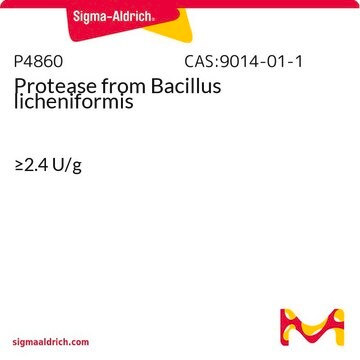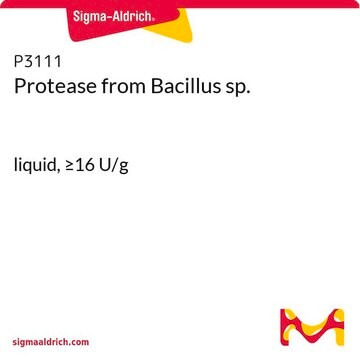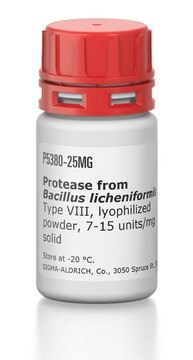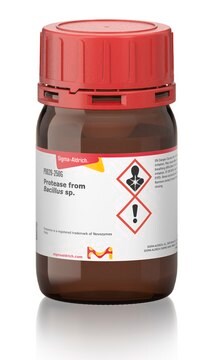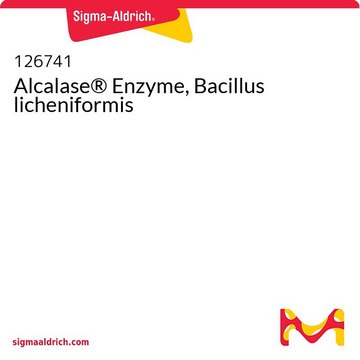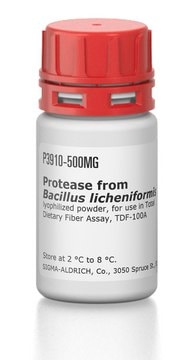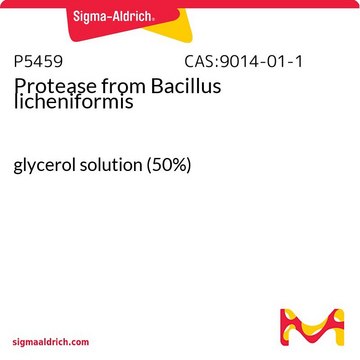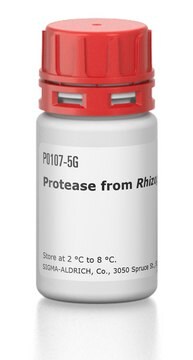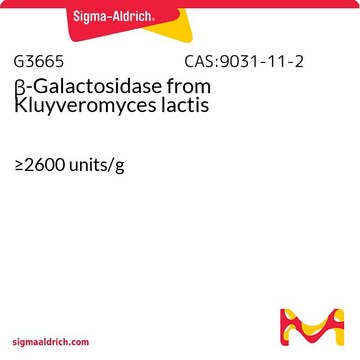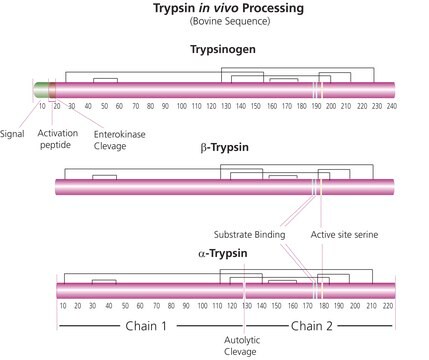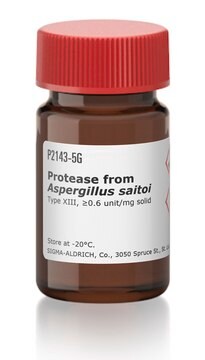P5860
Protease aus Bacillus sp.
liquid, ≥8 U/g
Synonym(e):
Esperase® 8.0L
Anmeldenzur Ansicht organisationsspezifischer und vertraglich vereinbarter Preise
Alle Fotos(1)
About This Item
Empfohlene Produkte
Form
liquid
Spezifische Aktivität
≥8 U/g
Mol-Gew.
20--30 kDa
Lagertemp.
2-8°C
Suchen Sie nach ähnlichen Produkten? Aufrufen Leitfaden zum Produktvergleich
Anwendung
Protease is an enzyme used to break down proteins by hydrolyzing peptide bonds. Product P5860 is secreted from Bacillus sp. It is a serine-type protease characterized by excellent perfomance at elevated temperature and pH. Protease is used to degrade proteins, to study protease inhibitors and to study thermal inactivation kinetics. The enzyme has been used to test UV radiation as an environmental friendly, non-thermal technology for sterilizing enzymes used in the food industry.
Biochem./physiol. Wirkung
Protease catabolizes proteins by hydrolysis of peptide bonds. Proteases are inactivated by serine active-site inhibitors, such as phenylmethylsulfonyl fluoride (PMSF) and diisopropylfluorophosphate. Proteases, secreted from Bacillus sp., typically have molecular weights ranging from 20,000 to 30,000. They are typcially stabilized by Ca2+ and have high isoelectric points.
Rechtliche Hinweise
A product of Novozyme corp.
Esperase is a registered trademark of Novozymes Corp.
Signalwort
Danger
Gefahreneinstufungen
Acute Tox. 4 Oral - Aquatic Acute 1 - Aquatic Chronic 2 - Eye Dam. 1 - Resp. Sens. 1 - Skin Irrit. 2 - STOT SE 3
Zielorgane
Respiratory system
Lagerklassenschlüssel
10 - Combustible liquids
WGK
WGK 2
Flammpunkt (°F)
Not applicable
Flammpunkt (°C)
Not applicable
Persönliche Schutzausrüstung
dust mask type N95 (US), Eyeshields, Faceshields, Gloves
Hier finden Sie alle aktuellen Versionen:
Besitzen Sie dieses Produkt bereits?
In der Dokumentenbibliothek finden Sie die Dokumentation zu den Produkten, die Sie kürzlich erworben haben.
Kunden haben sich ebenfalls angesehen
D R Durham et al.
Journal of bacteriology, 169(6), 2762-2768 (1987-06-01)
An alkalophilic Bacillus sp., strain GX6638 (ATCC 53278), was isolated from soil and shown to produce a minimum of three alkaline proteases. The proteases were purified by ion-exchange chromatography and were distinguishable by their isoelectric point, molecular weight, and electrophoretic
Elodie Lefebvre et al.
Materials science & engineering. C, Materials for biological applications, 82, 210-216 (2017-10-14)
Chronic wound colonization by bacterial biofilms is common and can cause various complications. An anti-biofilm strategy was developed around the co-entrapment of a commercially available antiseptic, PHMB (polyhexamethylene biguanide 4mgmL
Vadim Volkov et al.
International journal of biological macromolecules, 85, 476-486 (2016-01-13)
The current study describes the in vitro phosphorylation of a human hair keratin, using protein kinase for the first time. Phosphorylation of keratin was demonstrated by (31)P NMR (Nuclear Magnetic Resonance) and Diffuse Reflectance Infrared Fourier Transform (DRIFT) techniques. Phosphorylation
Effect of UV light on microbial proteases: From enzyme inactivation to antioxidant mitigation.
Lante A, et al.
Innovative Food Science & Emerging Technologies, 17, 130-134 (2013)
Unser Team von Wissenschaftlern verfügt über Erfahrung in allen Forschungsbereichen einschließlich Life Science, Materialwissenschaften, chemischer Synthese, Chromatographie, Analytik und vielen mehr..
Setzen Sie sich mit dem technischen Dienst in Verbindung.